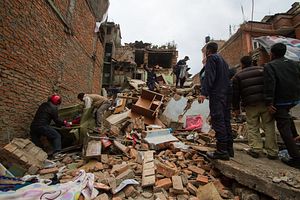On April 25, Nepal was hit by a 7.8-magnitude earthquake. Less than a month later, a second, 7.3-magnitude earthquake struck on May 12, followed (as the first quake had been) by numerous aftershocks. As of Sunday, May 17, Nepal’s Home Ministry has confirmed a death toll of at least 8,583, making this the most devastating and deadly disaster of Nepal’s history. As the rescue effort continues, the numbers of those who perished will no doubt continue to climb.
After the first earthquake, Japan was one of the countries that reached out to Nepal most quickly to provide various forms of disaster relief. To start, Tokyo immediately announced that it would provide a $14 million emergency grant aid package to Nepal, much of which will be disbursed through international organizations such as the World Food Program, the International Federation of Red Cross and Red Crescent Societies, and the United Nations Children’s Fund. Japan has always been quick to donate money, particularly given its own experience with major natural disasters, and this time was no exception. This time, however, we are seeing Japan’s “whole-of-the-government” approach to international emergency assistance, which embodies Japan’s “proactive contribution to peace.”
The Japanese government has three main tools for emergency assistance: dispatch of the Japan Disaster Relief (JDR) team, the provision of emergency relief goods, and emergency grant aid. In the case of Nepal, the timely dispatch of the JDR was particularly noteworthy. Getting relief efforts underway within 72 hours after a large-scale disaster is considered critical in disaster relief. Japan managed to dispatch its two inter-agency JDR teams — one focused on search and rescue/recovery and the other for medical support — to Nepal within 48 hours after the first big earthquake hit. Japan’s Self-Defense Forces (SDF) followed the next day to provide medical assistance and airlifts. Since the calamity first hit Nepal last month, Japan’s JDR teams have engaged in the following relief activities:
- Search and Rescue: A inter-agency search-and-rescue team of 70 personnel from MOFA, JICA, National Police Agency, Fire and Disaster Management Agency, and Japan Coast Guard was dispatched on April 26. The team concluded their operations and returned to Japan after two weeks.
- Medical: The first team of 46, composed of medical practitioners across Japanese government agencies, was sent on April 27 for approximately two weeks,. The second team of 34 personnel was sent on May 7.
- Relief operations by the SDF: Following a small pre-deployment assessment team, 20 SDF medical personnel were dispatched on April 28, to be followed by a group of approximately 110 personnel. The SDF has also been involved in airlift operations.
Today, the JDR medical support team and SDF continue their relief effort in Nepal.
As the Japanese Diet enters a fierce debate on the national defense legislation package this week, all eyes are on how the suggested legislative changes will enable the SDF to play a more active role in a situation that may require the use of force. While that debate is no doubt critical, the effective and timely inter-agency response displayed by Japan in in the immediate aftermath of the worst earthquake in Nepal’s recent history deserve greater attention, as it is nothing but a demonstration of Japan’s unwavering commitment to a proactive contribution to peace.
Yuki Tatsumi is Senior Associate of the East Asia Program at the Stimson Center in Washington, D.C. Hana Rudolph is a research assistant with the East Asia Program at Stimson.

































